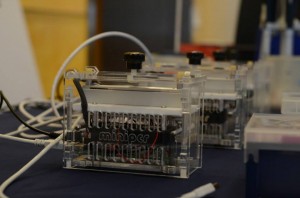Bringing Molecular Biology to classrooms
Modern biology is grounded in DNA analysis and its modification. DNA amplification through the Polymerase Chain Reaction (PCR) is an essential step in virtually every biotechnology application, including cloning, sequencing, diagnostics, crop improvement, medical genetics, forensics, and many others…
In the genomics era, no STEM curriculum is complete without including the theory, and ideally the practice, of PCR. Yet many schools today face challenges when implementing PCR labs.
Why? We’ve seen several barriers:
- 1. Thermal cyclers, or PCR machines, are too expensive.
The fundamental tool used in life sciences laboratories to amplify DNA is traditionally a heavy, bulky, and expensive piece of equipment, ranging in price from $2,000 to well over $10,000. For many learning labs the high price of thermal cyclers represents the largest barrier to teaching molecular biology .
- 2. Thermal cyclers are cumbersome to operate (and they are not student-friendly).
PCR machines currently on the market have been designed with research and diagnostics labs in mind. Further, thermal cyclers on the “affordable” end of the spectrum usually have antiquated interfaces that make setting up an experiment time-consuming and confusing. Thus running a PCR machine in the classroom often results in a “black box” experiment for the students: they hand samples to the teacher, walk away, and receive results after the PCR is completed. This muffles the possibilities for more inquisitive and experiential learning.
- 3. PCR labs are time-consuming (and not always fun).
We’ve heard many teachers eager to do PCR, yet concerned about PCR protocols taking too long, teachers needing to collect and pool student samples, then be tied to watching the samples for hours after students leave and the reactions complete. Students rarely own the end-to-end PCR experiment and instead have to rely on their teachers to handle samples, machine, and experiments.
Our goal through our products and this blog is to support teachers in creating a complete, engaging, and easily implementable biotechnology experience for their students. We’ll keep reflecting this commitment through our posts. And we encourage you to submit your concerns, questions, and ideas, to help build richer STEM experiences in biology and biotechnology.









